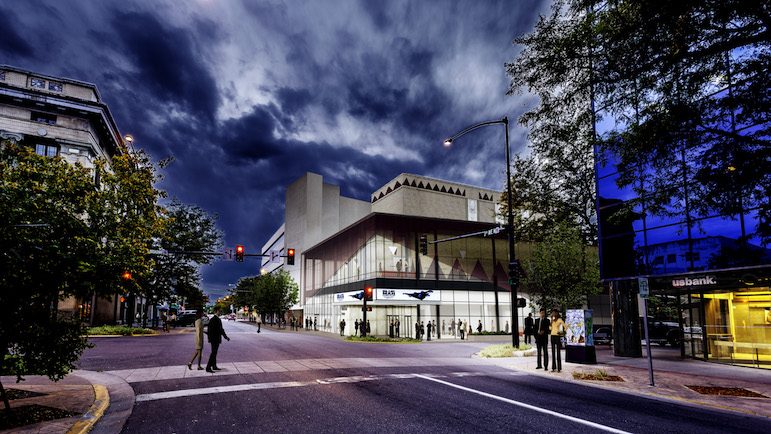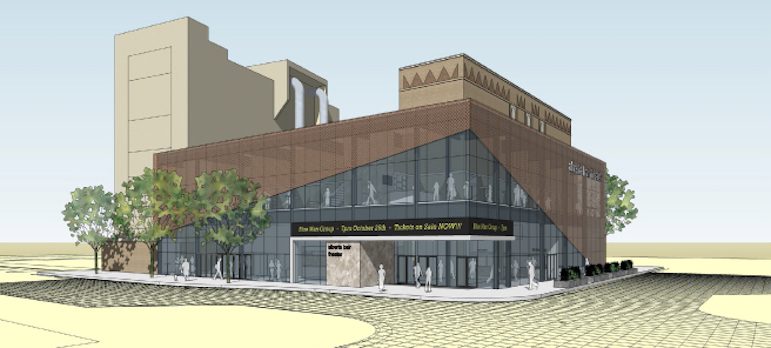Thirty years after the community saved the old Fox Theater in downtown Billings, Larry Martin is convinced the community will rally again behind a dramatic overhaul of the Alberta Bair Theater, successor to the Fox.
“At this point, it’s impossible to imagine downtown Billings without the Alberta Bair Theater, and I think the bulk of the community sees it that way,” Martin said.
Martin is the only member of the ABT’s current board of directors who was also on the board more than 30 years ago, when the City Council voted to buy the historic Fox, saving it from demolition, and giving supporters the chance to raise the $4 million it took to convert it to the Alberta Bair Theater.
It was named for its primary benefactor, the late Alberta Bair, whose family home once sat on the spot at North Broadway and Third Avenue North where the Fox was built in 1931.
The board and a host of other supporters are now hoping to make the first major upgrades to the theater since it opened as the ABT in January 1987. They hope to raise at least $7 million in time to start construction in the spring of 2019 and reopen an expanded, modernized theater in the fall of 2020.
The formal fundraising campaign has not been launched yet, but the effort got a huge boost last Monday, when the City Council voted unanimously to allocate $3.5 million in tax increment funds to pay for portions of the project, which has a total estimated price tag of $10.5 million to $11 million.
The city funds come from what is known as the Expanded North 27th Street Urban Renewal District, created to spur redevelopment of the downtown core. Any tax revenues in excess of the district’s base value at the time of the district’s creation go into a fund used to support projects like the ABT expansion.
In this case, the TIF funds will be used to install an elevator and bathrooms accessible to people with disabilities, as well as pay for upgrading the facade, stabilizing the structure and moving the sidewalk to accommodate an expanded theater.
The theater’s capital campaign will be used for a new roof, new sound and lighting systems, reupholstering the theater’s 1,400 seats, a new stage floor and orchestra shell, better stage rigging, more bathrooms and a greatly expanded lobby.A major component of the overhaul is replacing what Mike Tuss calls the “internally focused” facade with a two-story wall of glass designed to make the theater itself as much a spectacle as what takes place on its stage. Tuss, who worked on the design for CTA Architects, said the new facade will create “a sense of pageantry.”
Martin, the long-time board member, said the new facade will make the ABT “the beacon on Broadway.”
The enthusiasm of those involved, already quite high, has been higher still since the City Council approved the tax increment funding on Monday. Board President Brooke Murphy said the city action “revitalized our commitment,” and Martin said “we are now in a position to seriously start the fundraising process.”
Jan Dietrich, who has been the director of the ABT for a year but has been involved with the theater in various capacities since 1990, said the planned improvements are needed “to bring this theater into the current century.”
Considering all the advances in technology in the past 30 years, she said, the sound and lighting systems are long overdue for replacement, and the HVAC system still runs on an antiquated DOS operating system. It is so out of date, she said, that building temperatures have to be set 24 to 48 hours before an event—making it impossible to respond quickly to charges in the weather, or to the effects of a full house.

CTA Architects
An architect’s drawing shows the proposed expanded lobby of the Alberta Bair Theater, looking out to the south and east through walls of glass.
Dietrich said she was thrilled to be in the director’s seat during this important period of the theater’s life.
“It’s so exciting,” she said. “I am just honored to know that the board has the faith in me to go forward with this. I love the theater.”
Ron Yates, ABT board secretary, said the board has been talking about a renovation of the theater for at least 10 years, during which time numerous “critical infrastructure items” have been patched and repaired many times over.
And although one consultant had recommended at least considering moving into a new building somewhere outside the downtown, Yates said that option was never seriously entertained by the board.
“We wanted to keep it downtown, and our patrons and donors wanted to keep it downtown,” he said.
No specific pledges have been made to date, Yates said, but some key potential donors let it be known that if the project won the backing of the City Council, “they would certainly respond positively.”
The Fox Theater, built by 20th Century Fox, had been scheduled for demolition, to be replaced by a parking lot, until the City Council stepped in and agreed to buy the building in 1982. “It was by the skin of our teeth,” Martin said, because the vote was tied 5-5 until broken by the mayor.
After the city’s purchase, backers of the theater looked into fundraising to refurbish the building. Martin said they originally considered spending about $1 million on a renovation, with the idea that the space would be available to anyone who wanted to put on events there.
But a consultant hired by those supporters convinced them of two things: that they had to go with a much bigger renovation, and they had to form their own organization to run the building and bring in acts, as well as letting others stage productions there. The estimated cost was $4 million—coincidentally, just about $10 million in today’s dollars.
“That was kind of a shocker because we hadn’t planned on that,” Martin said of the ambitious plan.
But the supporters were able to convince the community of the need for a completely overhauled theater, and by the summer of 1985 they closed the theater for the reconstruction. By October 1986, the name of the building was changed to the Alberta Bair Theater, and it opened the following January.
The nonprofit Alberta Bair Theater Corp. has continued to operate the theater under a 30-year, dollar-a-year lease from the city, which was last renewed in 2012.
This time around, too, said past board president Bill Gottwals, “we knew going into it we couldn’t do something small. We had to go big.”
Hence the new facade, the expanded lobby and the new bathrooms. Tuss, the CTA architect, said the number of toilets on the mezzanine level will go from 22 to 40, and on the ground floor from two to 15. “That’s a big deal for patrons,” he said.
By expanding to the south and east, moving the building’s edge to what is now the edge of the sidewalk—eliminating a few parking spots on both sides of the theater—the lobby and the public space on the mezzanine will be much larger, Tuss said, “and much more useable and flexible for community gatherings.”
A large part of the board’s pitch to the community will be emphasizing the theater’s impact not just on local culture but on the local economy. Information provided to the City Council said the ABT had expenditures of $1.71 million in the 2015-16 season, and has an estimated annual impact of $4.2 million on the Billings economy.
In 2015-16, it hosted 84 events, drawing 84,440 patrons, about 9,200 of whom came from outside Yellowstone County. The theater also has 10 employees and 108 volunteers.
“The Alberta Bair Theater is the jewel of downtown,” Yates said. “We really think we are a huge economic driver for the downtown.”







